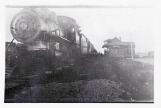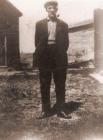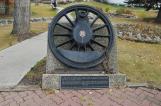1
First Train through Stony PlainThe 20th Century, Circa 1907
Stony Plain, Alberta, Canada
 Credits:
Credits:From the Multicultural Heritage Centre Archives
2
Israel Umbach "The Sheriff"20th Century, Circa 1910
Stony Plain, Alberta, Canada
 Credits:
Credits:From the Multicultural Heritage Centre Archives
3
Statue of Israel UmbahchThe 20th Century, Circa 1997
Stony Plain, Alberta, Canada
 Credits:
Credits:This sculpture was made by Shane Repka.
The photo was taken by Robin Lillywhite
4
Strong Arm of the LawThe 20th Century, Circa 1990
Stony Plain, Alberta, Canada
 Credits:
Credits:This mural was painted Doug Driediger
The photo was taken by Robin Lillywhite
5
Monument to Israel Umbach when he chained the train to the rails for not paying taxes2 July 1980
Stony Plain, Alberta, Canada
 Credits:
Credits:Photo taken by Robin Lillywhite for the Multicultural Heritage Centre Archives
6
Israel UmbachBy Trevor Miller
The R.C.M.P. has been serving in Stony Plain for over 100 years but, in 1909 more desperate measures were called for: Stony Plain needed a sheriff. That man was Israel Umbach.
In 1892, Umbach moved with his family from Waterloo, Ontario, to Edmonton. It took seven days and nights by train to move his wife, Louisa, and their three children across Canada.
Israel built the first livery barn, the first bank, the school, the Methodist church, the old fire hall, and a number of other buildings in and around Stony Plain.
After the development of Stony Plain as a townsite, Umbach was the law- enforcement officer, acting as sheriff. In 1909, he was appointed town constable by order of town council.
Serious matters were reported to the North West Mounted Police, now known as the Royal Canadian Mounted Police, so Umbach was often required for lesser matters out of town, sometimes as far away as Edson.
As sheriff, Umbach was in charge of collecting taxes. One of the most colourful times in his term of office came when the Canadian Northern Railway wouldn't pay their taxes.
When Sheriff Umbach heard the train whistle as they came into town, he dropped the work that he was doing and strolled determinedly into the Oppertshauser hardware store. There, he bought the heaviest duty chain he could find, and a big padlock.
He then walked over to where the giant engine was sitting and chained it to the tracks. The train could have tried to move, and eventually the chain would have broken, but not without extensive damage to the wheel or tracks.
When an agitated engineer came out to see what the commotion was all about, he was astonished, and immediately telegraphed his head office. A few hours and more telegraphs later, the railway agreed to pay the taxes and the train was on its way… behind schedule.
Mr. Umbach served the town well, and later passed away at the age of 81 years in 1948. His wife passed away in 1962, and is buried beside him.